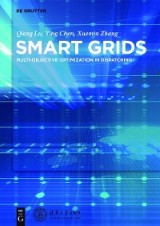Details

Smart Power Systems and Smart Grids
Toward Multi-objective Optimization in Dispatching1. Aufl.
|
116,95 € |
|
| Verlag: | De Gruyter |
| Format: | EPUB |
| Veröffentl.: | 21.02.2022 |
| ISBN/EAN: | 9783110448023 |
| Sprache: | englisch |
| Anzahl Seiten: | 239 |
DRM-geschütztes eBook, Sie benötigen z.B. Adobe Digital Editions und eine Adobe ID zum Lesen.
Beschreibungen
<p>The book systematically introduces smart power system design and its infrastructure, platform and operating standards. It focuses on multi-objective optimization and illustrates where the intelligence of the system lies. With abundant project data, this book is a practical guideline for engineers and researchers in electrical engineering, as well as power network designers and managers in administration. </p>
<p>Table of content:<br>Chapter 1 Introduction<br>1.1 Review of the Concept of Digital Power System (DPS)<br>1.2 Definition of Smart Power System (SPS)<br>1.2.1 Smart Power System (SPS) and Smart Wide Area Robot (S-WAR)<br>1.2.2 Summary of Smart Power System<br>1.2.3 SEMS and Chinese Smart Power System<br>1.3 Significance of the Construction of Smart Power System<br>1.3.1 Radically Improvement in Disaster Prevention Capability<br>1.3.2 Significant Improvement in Economic Performance Index and Power Quality<br>1.4 Foreign Research Status<br>1.4.1 IECSA Project<br>1.4.2 Seamless Communication Architecture of Power System<br>1.4.3 PJM Advanced Control Center [6]<br>1.4.4 IBM Intelligent Utility Network<br>1.4.5 Advanced Distribution Automation<br>1.5 Conclusion<br>Chapter 2 Summary of Hybrid Control Theory of Power System (HCTOPS)<br>2.1 Introduction<br>2.2 Dichotomy of State Space<br>2.3 E Transform and X Transform<br>2.4 Geometric Meaning of Double Transform<br>2.5 Multiple Near-optimal Index States Sets<br>2.6 Events Start Control, Control Eliminate Events<br>2.7 Time Base and Events Base<br>2.8 Discussion about Hybrid Control System Architecture and Some Problems<br>2.9 Conclusion--Smart Wide Area Robot<br>Chapter3 Smart Power System Infrastructure<br>3.1 Introduction<br>3.2 Digital Substation<br>3.2.1 Definition of Digital Substation<br>3.2.2 Basic Contents of the Construction of Digital Substation<br>3.3 Digital Power Station<br>3.3.1 Definition of Digital Power Station<br>3.3.2 Basic Contents of the Construction of Digital Power Station<br>3.4 Digital Line<br>3.4.1 Definition of Digital Line<br>3.4.2 Basic Contents of the Construction of Digital Line<br>3.5 Conclusion<br>Chapter 4 Basic Platform for Smart Power System<br>4.1 Introduction<br>4.2 Basic Communication Platform<br>4.2.1 Needs of Basic Communication Platform<br>4.2.2 Basic Communication Platform Architecture and Technology<br>4.3 Data Sharing Platform<br>4.3.1 Needs of Data Sharing Platform<br>4.3.2 Data Sharing Platform Architecture and Technology<br>4.3.3 Advanced State Estimate for Real-time Data Sharing of Kernel<br>4.4 Conclusion<br>Chapter 5 Standard Index System of Smart Power System Operation<br>5.1 Introduction<br>5.2 Establishment of Operating Standards Index System<br>5.2.1 Construction Approaches<br>5.2.2 Basic Composition<br>5.2.3 Establishing Process<br>5.3 Security Index<br>5.3.1 Research Background<br>5.3.2 Numerical Approximation of the Shortest Radius of Voltage Security Domain<br>5.3.3 Numerical Approximation of the Shortest Radius of Small Signal Security Domain<br>5.3.4 Numerical Approximation of the Shortest Radius of Transient Security Domain<br>5.3.5 Numerical Simulation<br>5.4 Control Performance Index of Interconnected Power System<br>5.4.1 Brief Introduction to Interconnected Power System Active Power Control Performance Index<br>5.4.2 Brief Introduction to Interconnected Power System Reactive Power Control Performance Index<br>5.5 Conclusion<br>Chapter 6 Events Analysis and Treatment Technology<br>6.1 Introduction<br>6.2 Advanced State Estimate Algorithm<br>6.2.1 Main Idea<br>6.2.2 Methods Introduction<br>6.2.3 Methods Characteristics<br>6.2.4 Example<br>6.3 Computation Algorithm of Optimal Power Flow Based on Constraints Conversion Technology<br>6.3.1 OPF Model<br>6.3.2 Algorithm Steps<br>6.3.3 Examples Analysis<br>6.4 Conclusion <br>Chapter 7 Smart Power System Visualization<br>7.1 Introduction<br>7.2 Contents of Smart Power System Visualization<br>7.2.1 Operation State Visualization<br>7.2.2 From State Visualization to Monitoring Visualization<br>7.3 Topology Self-generation<br>7.3.1 Basic Idea<br>7.3.2 Single Line Figure Self-generation<br>7.3.3 Power Station Main Wiring Graph Self-generation <br>7.4 Fast Graphic Rendering Algorithm<br>7.4.1 Interpolation Algorithm Analysis<br>7.4.2 Mesh Mergence Method<br>7.4.3 Application Example<br>7.5 Conclusion<br>Chapter 8 SEMS System<br>8.1 Introduction<br>8.2 Definition and Characteristics of SEMS<br>8.2.1 Definition of SEMS<br>8.2.2 Characteristics of SEMS<br>8.2.3 SEMS and EMS<br>8.3 Composition of SEMS<br>8.3.1 Events Analysis System<br>8.3.2 Events Treatment System<br>8.3.3 Dispatcher Decision System<br>8.4 Events Analysis Models in SEMS<br>8.4.1 Security and Stability Events Judgment<br>8.4.2 Power Quality Events Judgment<br>8.4.3 Economic Operation Events Judgment<br>8.5 Events Treatment Models in SEMS<br>8.5.1 Security and Stability Events Treatment<br>8.5.2 Power Quality Events Treatment<br>8.5.3 Economic Operation Events Treatment<br>8.6 Controllable Resources<br>8.6.1 Classified by Information Used by Control<br>8.6.2 Classified by Control Response Time<br>8.6.3 Classified by Power System Operation State Aimed by Control<br>8.7 Layered Hierarchical Architecture of SEMS<br>8.8 Conclusion<br>Chapter 9 Smart Power System<br>9.1 Introduction<br>9.2 Definition of Smart Power System<br>9.3 Improving Ideas, Constructing Modern Main and Distribution Network<br>9.4 Making Load be the Subject of Peak Regulation<br>9.5 Double-side Energy Management System of Smart Power System<br>9.5.1 User-Smart Energy Management System (U-SEMS)<br>9.5.2 Dispatch-Smart Energy Management System (D-SEMS)<br>9.6 Developing New Technology, Achieve Smart Dispatching<br>9.7 Distributed Energy System in Smart Power System<br>9.7.1 Distributed Energy Technology<br>9.7.2 Energy Storage Technology<br>9.7.3 New Technology Areal Dispatch Center and User's Interaction<br>9.8 Conclusion<br></p>
<p><strong>Qiang Lu</strong>, <strong>Ying Chen</strong>, <strong>Xuemin Zhang</strong>, Tsinghua University, Beijing, China.</p>


















